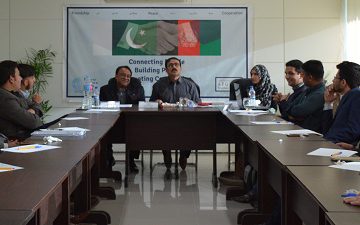The Famine Early Warning System (FEWS) has reported that in 22 of Afghanistan’s provinces, cumulative rain and snowfall during the ‘wet season’ – October 2017 to May 2018 – was 30 to 60 per cent below average. The northwest of the country has been particularly hard hit. AAN’s Jelena Bjelica (with input from Obaid Ali and Kate Clark) reports on drought and displacement there and looks at the underlying problems – climate change and government neglect.
A closer look at the consequences of the drought in the northwest
Locals from the northwest Afghanistan say this year’s drought is the worst they remember. “I don’t remember it being this dry,” former Badghis MP Mullah Malang told AAN, “since I was 14 or 15 years old. That was in 1964.” Available reports show that drought there has crippled the local, mainly rainfed agriculture and left people without the basic means to survive. The World Food Programme (WFP) reported on 24 July 2018 that it plans to distribute urgent food assistance to 441,000 people in the drought-affected provinces of Badghis, Faryab, Ghor, Herat and Jowzjan. Some people have already been forced to leave their homes in these provinces.
The United Nations (UN) Office for Coordination of Humanitarian Affairs (OCHA) reported in July 2018 (see here) that approximately 7,400 families, or over 50,000 people, have moved in the past months to Herat city from neighbouring Badghis and Ghor provinces as a result of drought and conflict. Badghis’s population is a little over half million people, according to the Afghan Central Statistics Organization 2017/18 census estimates (see here), of which over 496,000 people are from rural communities. Similarly, of a total of over 738,000 people in Ghor province, only some 7,700 live in urban settlements.
The 7,400 displaced families, according to the Norwegian Rescue Committee assessment, reside in 174 sites on the outskirts of Herat city on the road to Badghis. The number of families at each site ranges from 20 to several hundred. 1,760 families have received tents, while others live in makeshift shelters on open land in high summer temperatures of around 40 degrees Celsius. The humanitarian workers in the area said they have never seen people living in such disheartening conditions. They said they are living on bread and water, as they do not have enough money to afford rice or meat. OCHA, in its report, said that “children show visible signs of malnutrition and illness, including skin diseases and eye infections due to dust.” None of the children in the displacement sites attend school, it said, and in rural villages the dropout rate is high for boys and girls.
Shir Aqa, a landowner from Faryab, confirmed Mullah Malang’s assessment that this is the worst drought seen in decades and said some men from his province had migrated even further away than Herat to Iran, Pakistan and Turkey in search of work. According to the OCHA report, this traditional coping mechanism, ie labour-driven migration, may be less effective than in previous years. The report quotes an Afghan from Badghis who sent two sons to Iran. “One got arrested and deported, and the other is still hiding in Iran but has not found any work,” he told the UN. The latest reports also show that the number of deportations from Iran is on increase (see here). This coincides with an Iranian currency devaluation by some 40 per cent over recent months (see here).
Another UN report seen by the author reports that families from areas where the impact of drought has been compounded by conflict have said they will not return to their villages, “even if they received food assistance in the areas of origin.” (1) This is because “they expected the conflict would still be ongoing for at least six months.” Instead, these families have chosen to stay in the overcrowded camps in and around Herat city. Some international organisations have reported increased tensions between long-term and newly-arrived Internally Displaced People (IDPs) and between IDPs and local residents in some locations. The same report said “there were a few incidents of killing, maiming and abduction of children reported by the families in the sites,” adding that “displaced people in informal settlements in Herat city live amongst poor host communities,” in which “sharing of resources, as an expression of solidarity, is something few families can afford.”
Various north and north-west provinces– Samangan, Balkh, Sar-e Pul Faryab and Badghis, as well as the northern parts of Ghor and Herat – generally suffer more than the rest of the country from extended dry spells, localised drought, and above average temperatures (see this report by the USAID-funded Famine Early Warning System (FEWS). (FEWS covers 36 countries around the globe, rather than being a local natural disaster management authority).
The extended dry spells and drought in the northwest are related to local changes in climate in this part of Afghanistan that have been triggered by deforestation during the four decades of war and, subsequently, a lack of planned development and adequate management of natural resources. The Afghan government said in 2015 in its Paris Climate Change conference documents that between 1990 and 2000 the country lost on average 29,400 hectares of forest per year (see AAN analysis here).In Badghis province, for example, climate change has also been caused by extreme deforestation in the province over the last forty years. The WFP reported in 2017 that, based on Department of Agriculture records in Badghis, there were 90,000 hectares of pistachio forest before the war, ie before 1978, and that drought and cutting of the forest for firewood has left the province with only some 28,000 hectares, one third of the original forest. The Independent newspaper, described Badghis in 2014 as a province where “grain has become the only currency that matters,” and was then in “its fourth year of a drought, which has destroyed the rural economy.”
In these provinces, opium poppy cultivation has increased at the expense of wheat (see AAN analysis here). One reason for this switch might be the scarcity of water, as opium poppy is relatively more drought-resistant. Usually, however, the reasons behind a farmer’s decision to cultivate opium are multiple, as reported in a number of studies (see here; here and here). (2) Nevertheless, in the northern region of Baghlan, Balkh, Faryab, Jawzjan, Samangan and Sar-e Pul, the United Nation Office for Drug Control (UNODC) has noted a rapid expansion of opium poppy cultivation since 2014 (see this AAN analysis). The FEWS June 2018 outlook found that opium poppy cultivation in this zone in 2018 had increased by approximately 10 to 15 percent when compared to the 2017 figures. The report also reported a decrease in the area under wheat. The report offers a rather grim economic prospect, “the brief poppy harvest generates some local employment opportunities, often paying several times the wage rate of other sectors for a period of roughly two weeks.”
According to the FEWS outlook, licit agriculture production in this zone in 2018 is expected to fall below the production levels of 2017 – then already below the national average – while, “the availability of drinking water and fodder for the livestock are significantly worse than normal.” The FEWS reported:
Field reports indicate that June livestock prices are 30 to 40 percent lower than last year. Many drought-affected households are selling their livestock in unusual high quantities due to the need for cash and due to inability to properly care for the animals.
AAN interviews with farmers from Faryab and Sar-e Pul provinces confirmed that livestock prices have dropped in the north because of the drought and shortage of summer pasture, and that animals are being sold for almost half the usual price. Shortage of rainfall has badly affected the farmers in these provinces, where the prices for wheat, rice and other staple food have all gone up. Shir Aqa, the landowner in Faryab, told AAN that no-one remembers a drought this bad:
Some wheat always grew, not as tall as usual, but it grew, and also poppy. Humans could not use the crops, but at least the animals could. They had fodder. This time, we don’t even have that.”
Both he and former Badghis MP Mullah Malang pointed to the steep drop in the price of sheep in their provinces, from around 7-8,000 Afghani to 1,500 Afghani. For Malang, this was an unquestionable sign of trouble yet to come. Selling livestock because there is not enough grazing to keep flocks alive or because of the need for cash for food means is a survival strategy of last resort. Malang said worse is to come:
“In two or three months’ time, the pressure will be much greater. Winter is coming, food stocks will be finished, and the number of people escaping the province will go up.”
Changing climate conditions in Afghanistan
Climate change and climate hazards in Afghanistan were well-documented in the 2009 National Capacity Needs Self-Assessment for Global Environmental Management (NCSA) and National Adaptation Programme of Action for Climate Change (NAPA) Afghanistan final report. This document identified the key climate hazards for the country as periodic drought and a rise in temperature (see also this the 2017 Guardian report from the Afghanistan’s central highlands).Since 1960, the document said, the country has experienced regular droughts: two in the 1960s, in 1963-64 and 1966-67; one in the 1970s, in 1970-72; and the longest and most severe drought in Afghanistan’s known climatic history between 1998 and 2005/6 (see also AAN analysis here). The Stockholm Environmental Institute said in 2009 that “drought is likely to be regarded as the norm by 2030, rather than as a temporary or cyclical event.”
In June 2018, the FEWS warned that below average wet season precipitation levels will lead to a reduction in yields for rainfed staple crops, lower quality grazing pastures and poor livestock conditions and lower animal prices. In February 2017, FEWS released a similar warning as the October – December 2016 precipitation had been below average throughout most of the country. This shows that, for the second year in a row, Afghanistan is facing below-average precipitation levels during the wet season (October to May). These have coincided with the atmospheric condition called La Niña. (3)
The two dry spells combined resulted in the lowest detected ‘snowpack’ in Afghanistan in February 2018 since 2001, the National Aeronautics and Space Administration(NASA’s) earth observatory reported. Snowpack is made up of accumulated layers of snow, compressed and hardened by their own weight, and are an important source of irrigation in much of Afghanistan. e above-average spring temperature in 2018 has also led to a roughly one month earlier than normal melt and depletion of snowpack in most basins. The snowmelt and increased precipitation levels late in the season resulted in deadly floods in Panjshir province in early July 2018 (see here, here, and here).
For Afghanistan’s agriculture, which is 80 per cent rainfed, low precipitation is potentially disastrous. TheFEWS Food Security Outlook in June 2018 estimated that there will be a 2 to 2.5 million metric tonne national deficit in wheat, with most crop losses occurring in rainfed areas in the north, central, and western provinces. The domestic production of staples is already below average, particularly in rainfed production areas, FEWS reported, adding that most grazing pasture in the central highlands and northern Afghanistan had not regenerated as normal and that this would likely lead to poor livestock conditions and lower animal prices. As was reported above, this is already the case.
FEWS also found that on-farm labour demand and wages in June 2018 were lower than normal in most parts of the country and especially in the northern, north-eastern, and north-western rainfed wheat growing areas. Among the most likely food security outcomes for the whole country, the FEWS outlook from June 2018 reported that:
The prevalence of acute malnutrition at the national level is likely to deteriorate over the scenario period [July 2018 to January 2019], because of seasonal peak of diarrheal diseases from June to September. Furthermore, constant conflict, particularly in western, southern, eastern, northern, and northeastern regions, is also likely to limit access to health and nutritional services and access to agriculture products and food.
In April this year, the spokesman for the Afghanistan National Disaster Management Authority in Kabul, Hashmat Khan Bahaduri, told Reuters that “this year drought has reached a level that we will have to announce an emergency in several parts of the country.” It seems, though, that the emergency warning has not been issued yet, not even for the north and northwest of country which have been so hard hit this year.
Nevertheless, OCHA recently launched the revised 2018 Humanitarian Response Plan asking for an additional 84 million USD for food assistance to drought-affected people (see here). Currently, only 29 per cent of the 546.6 million USD 2018 Humanitarian Response Plan is funded.
Conclusion
Prolonged dry spells, compounded with the fighting in the northwest, have taken their toll on the lives of ordinary people. It is evident that the situation there calls for the relevant government authorities to take a more proactive and engaged role. However, the government’s lack of initiative or preparedness to deal with the consequences of natural disasters is striking. Afghanistan is one of 168 countries who are signatories to the Hyogo Framework for Action (HFA) 2005 – 2015 that states a need for member states to “identify, assess and monitor disaster risks and enhance early warning.” Yet, the government has failed to respond to the early warnings provided by FEWS.
Afghanistan does have a body which should be doing this. The Afghanistan National Disaster Management Authority (ANDMA) was established in 2007, following the 2006 London Conference Communique, which stated, “[B]y end‐2010, an effective system of disaster preparedness and response will be in place.” The ANDMA has received an abundance of funding from a number of international organisations, including capacity-building from the United Nations Development Programme (UNDP), International Organisation for Migration (IOM) and United Nations Environment Programme (UNEP). Today, its website is still under construction and offers only one news-related item concerning the current situation in the northwest, ie the distribution of food items in Faryab province in June 2018.
The WFP, in its June 2018 Afghanistan update, reported that the Central Statistics Organization, and not the ANDMA, was leading a post-harvest emergency food security assessment with support from WFP, Food and Agriculture Organisation (FAO) and the Food Security and Agriculture Cluster. This suggests that the Central Statistics Organization is the lead for drought response assessment. The ANDMA has not been mentioned at all in any of the recent drought-related reports and appeals.
As to the country’s latest national disaster management plan, it is four years old, dating from 2014 (Dari version here; see here for related documents and plans). According to the United Nations Office for Disaster Risk Reduction (UNISDR) 2017 guidelines on national disaster risk assessment, such plans are usually produced in time horizons of three to five years. However, as the Afghan plan does not stipulate which timeframe it covers, its relevance for the current situation, caused by the relatively recent La Niña conditions, is questionable.
Finally, AAN sources in the northwest said that most government offices in this part of the country are not open, indicating that local early warnings through the relevant ministries probably also did not happen.
Yet the desolate situation in ‘remote’ provinces such as Ghor, Badghis, Samangan, and parts of Faryab is also a consequence of a lack of development. As AAN recently reported on the state of aid and poverty, around 40 per cent of the country has not been privy to donor funds. Badghis province, in particular, has suffered from a lack of development funding (see this AAN analysis). There has been a lack of targeted development to mitigate the effects of regular and expected climatic crises such as droughts. This raises the question of whether displacement from the northwest is only a consequence of natural disaster or is also a result of government neglect and lack of planning.
(1) Report: Inter-Cluster Coordination Team Mission Herat and Badghis 7 – 11 July 2018. Seen by author, not available online.
(2) An Afghanistan Research and Evaluation Unit (AREU) paper (quoted here), for example, points to a combination of factors beyond infrastructure that feed into farmers’ decisions to grow opium poppies as opposed to alternative crops. These include the following: (i) the position of key elites vis-à-vis poppy cultivation, (ii) food security, and (iii) social equality. This means that, where key government officials or power-holders are opposed to poppy cultivation, their opposition could prevent farmers from planning the crop, even where conditions otherwise seemed ripe for it. In addition, AREU found that greater food security and social equality lead to reduced poppy cultivation. Ultimately, the study found that that “the absence of opium cultivation was more than a matter of water.” Therefore, the report suggests that water availability is a necessary, but insufficient, condition to enable a switch to alternative crops. In fact, under certain conditions, strong irrigation systems may incentivise poppy cultivation.
See also this AREU paper from 2007 which states:
For the poor, opium poppy is attractive because it is a low-risk crop in a high-risk environment, not because it allows them to maximise economic returns. Some crops — particularly as part of mixed cropping systems and combined with non- farm income opportunities — can compete in terms of financial returns with opium poppy when opium prices are lower, but no crop can offer the same qualitative attributes, including: relative drought resistance, a non-perishable product, an almost- guaranteed market, and traders who offer advance payments against the future crop.
A word of caution related to opium prices; UNDOC found that, during years of high production, eg 2006 to 2008, the average price decreased (137 USD in 2006 to 91 USD/kg in 2008), whereas, following a supply shortage (for example, the Taleban ban on opium in 2001), the average price strongly increased (295 USD/kg in 2001; 382 USD/kg in 2002; 355 USD/kg in 2003). In 2017, an average price of opium was 155 USD/kg. For more see here.
See also this 2006 AREU case study on Balkh and Kunduz’s opium cultivation and water management, which says: “It is also unlikely that there is any one single determinant for whether or not opium poppy is cultivated – there are multiple reasons and farmers’ decision-making is contingent on context and time.”
(3) La Niña, the direct opposite of El Niño, occurs when sea surface temperatures in the central Pacific Ocean drop to lower-than-normal levels. The cooling of this area of water near the equator, which typically unfolds during late fall into early winter, yields impacts around the globe. (see here).
La Niña conditions in the atmosphere tend to push the jet stream northward over Central Asia and reduce the frequency of storms over Afghanistan, leading to a reduction in precipitation totals and an increased risk for dry spells. This anticipated weather pattern generally occurred over Afghanistan, particularly through the winter and early spring. Although precipitation improved late in the season, seasonal totals in some areas remained 50 percent below average according to satellite-based estimates, with extended periods of dryness and drought in much of the northern part of the country, particularly the northwest. Accordingly, peak snow water equivalent in most hydrological basins was well below average. Low total snowpack and above-average spring temperatures have led to early depletion of snowpack in most basins, roughly one month earlier than normal. FEWS NET’s Seasonal Monitor report from June 6, 2018 provides further summary of the 2017/2018 wet season.
According to the Environmental Science website El Niño and La Niña change or affect climate change in the future is now of tremendous importance thanks to the known effects over the last century or more. However, “the conditions are still not very well understood, though the phenomenon has been known since the early 1600s.”
By Special Arrangement with AAN. Original link.
Disclaimer: Views expressed on this blog are not necessarily endorsed or supported by the Center for Research and Security Studies, Islamabad.








